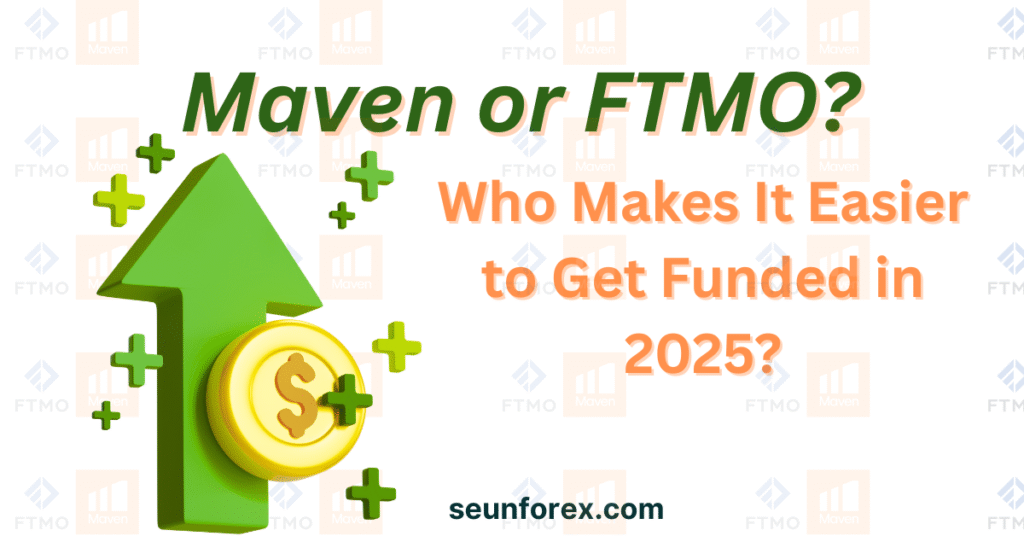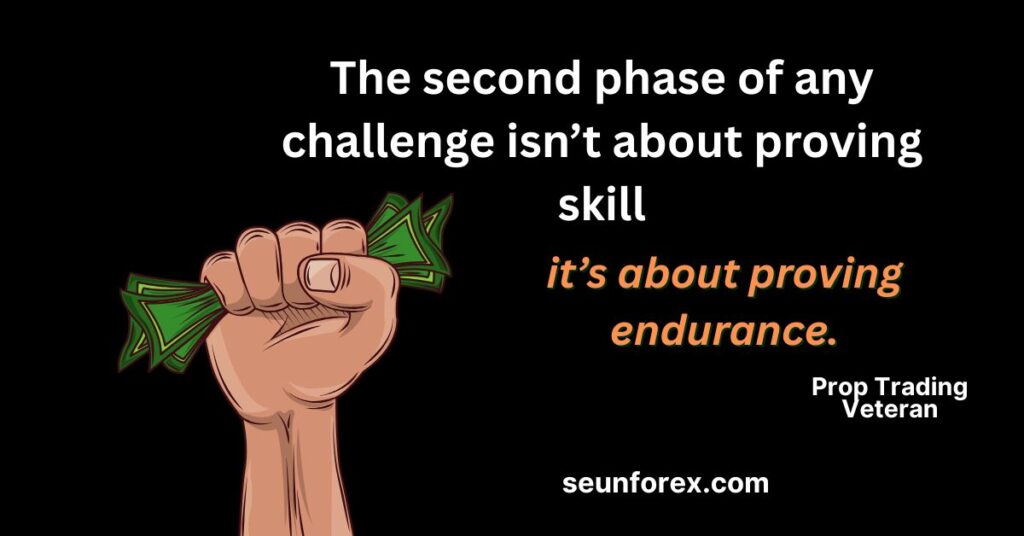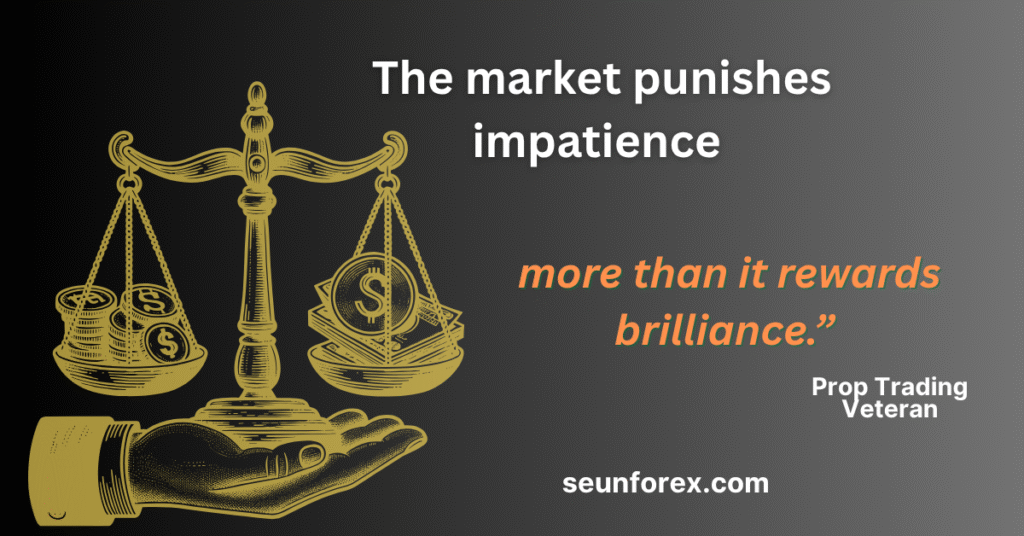
Maven Trading vs. FTMO — The Landscape of Proprietary Trading Is Shifting
The world of prop firm evaluations in 2025 is evolving fast. In the debate of Maven Trading vs. FTMO, the journey to becoming a funded trader has long been a well-defined, if arduous, path dominated by one model — the timed, two-step evaluation. Proprietary trading firms, as defined by Investopedia, are companies that trade their own capital rather than clients’ money — allowing skilled traders to access firm-funded accounts based on performance. These firms have traditionally used this model to assess traders’ discipline, consistency, and ability to manage risk under pressure. FTMO was the undisputed king of this mountain, its 30-day challenge a brutal rite of passage that separated the disciplined from the desperate.
Then, a challenger emerged. Maven Trading, a prominent European prop firm, gained rapid traction with a compellingly simple proposition: a One-Step Evaluation with Unlimited Time. The Maven Trading vs. FTMO debate truly began when Maven directly addressed two of the biggest trader pain points — the pressure of time limits and the frustration of multi-phase challenges.
But in a move that has reshaped the industry, FTMO responded by removing its 30-day time limit. The playing field, once tilted, has now leveled — making the Maven Trading vs. FTMO 2025 comparison more relevant than ever. This shift has forced traders to re-examine which firm offers the easier path to funding and a more psychologically sustainable challenge.
This leaves you, the serious trader, with a critical question: in this new era of PropFirm Evaluation 2025, which challenge truly provides the clearest path to consistent funding? Is Maven’s one-step model the easier route for beginners, or has FTMO’s rule update made it the smarter long-term choice?
This isn’t a superficial FTMO Challenge Review or Maven Trading Review. This is a deep, data-driven, and psychological analysis designed to give you a measurable edge. We’ll break down the rulebooks, model risk exposure, and explore the psychological warfare both challenges impose on the trader’s mind.
Our goal isn’t to crown a winner but to help you select the battlefield where your trading system and mindset can thrive.
Let’s begin with the cold, hard facts about Maven Trading vs. FTMO — and what this rivalry really means for modern traders in 2025.
Part 1: The 2025 Rulebook – A Tactical Breakdown
Before we dive into psychology, we must master the mechanics. Every successful campaign is built on a foundation of quantifiable rules. Here is a detailed, side-by-side comparison of the current structures for a standard $100,000 account.
| Feature | FTMO (Two-Step) | Maven (One-Step) | The Strategic Implication |
|---|---|---|---|
| Profit Target (Step 1) | 10% ($10,000) | 10% ($10,000) | The initial hurdle is identical. Both require the same initial performance. |
| Profit Target (Step 2) | 5% ($5,000) | N/A | This is a major differentiator. FTMO requires a second, lower-profit verification phase. |
| Max Daily Loss | 5% (Trailing from Equity) | 5% (Static from Initial Balance) | The most critical difference. This single rule creates vastly different risk environments. |
| Max Total Loss | 10% (of Initial Balance) | 10% (of Initial Balance) | The overall “blow-up” point is the same. The journey to that point is not. |
| Time Limit | Unlimited (Both Steps) | Unlimited | A game-changing update from FTMO. The pressure of the countdown clock is gone. |
| Minimum Trading Days | 10 (Total across both steps) | 5 | A minor logistical point, but Maven offers slightly more flexibility. |
TheMaven Trading vs. FTMO – The Devil in the Details: Understanding Drawdowns
The Maven Trading vs. FTMO comparison becomes most revealing when you dig into how each firm handles drawdowns — the subtle but powerful rule that determines how long a trader survives under pressure. The terms “Trailing” and “Static” are often mentioned but rarely understood in their full consequence. Let’s model a scenario to see the dramatic difference.
Scenario: You start with a $100,000 account. You execute well and build a $7,000 profit, bringing your account equity to $107,000.
UndUnder Maven Trading’s Static Drawdown, your maximum loss floor is fixed at $90,000 (Initial Balance – 10%), while your daily loss limit remains at $95,000 (Initial Balance – 5%). This means you’re $17,000 away from your Max Loss and $12,000 away from your Daily Loss limit — a substantial cushion compared to most prop firms in the Maven Trading vs. FTMO comparison.
What this means for traders in the PropFirm Evaluation 2025 landscape is simple: Maven provides a significant psychological buffer. A bad day or a series of small losses is unlikely to trigger disqualification. This fosters a “grinder” mentality — a steady, patient approach that rewards consistency over aggression. It’s one of the reasons many Maven Trading Review discussions highlight its easier prop firm structure for beginners, especially when compared to the stricter, trailing models seen in FTMO Challenge Reviews.
Under FTMO’s Trailing Drawdown:
- Your Maximum Loss floor is static at $90,000.
- Your Daily Loss is a trailing 5% from your peak equity. At $107,000 equity, your Daily Loss limit becomes $107,000 – $5,000 = $102,000.
- Your Cushion: You are still $17,000 from your Max Loss, but you are only $5,000 away from your Daily Loss limit.
What this means: Your daily safety net does not grow. A single bad day that retraces $5,000 from your peak equity—even if you’re still up $2,000 overall—will violate the daily rule and fail the challenge. This demands impeccable consistency and punishes drawdowns harshly.
The Takedown: While the overall loss limit is the same, Maven Trading’s static drawdown provides a permanently widening safety net as you profit. FTMO’s trailing drawdown keeps a tight, fixed leash on your daily performance, creating an environment where you must protect paper profits aggressively.
This detailed look at Maven Trading vs. FTMO highlights how a single rule — static versus trailing — can dramatically alter your risk experience and your trading psychology.

Part 2: The Psychology of the Grind – Where Accounts Are Really Won
Rules are a framework; your mind is the engine that operates within it. The psychological demands of each challenge are profoundly different.
The Two-Step Marathon vs. The One-Step Sprint
FTMO’s two-step process is a test of endurance and resilience. Passing the first step is a euphoric moment, but it is immediately followed by the sobering reality of the Verification phase.
- The Psychological Hurdle: You must reset your mental clock. The 5% profit target in Verification may be smaller, but the pressure can feel greater. The fear of losing a funded account you feel you’ve already earned is a unique and potent form of psychological stress. It tests whether your initial success was due to luck or repeatable process.
Maven’s one-step process is a test of focused execution.
- The Psychological Advantage: There is one goal, one finish line. The path is linear and clear. This simplicity reduces cognitive load and allows you to channel all your mental energy into a single, sustained push for the 10% target. There is no “second round” to subconsciously dread, which can lead to self-sabotage at the end of the first phase.
Unlimited Time: The Great Equalizer and Its Hidden Pitfalls
The removal of time limits is the most significant industry shift in proprietary trading and PropFirm Evaluation 2025, reshaping how traders approach both the Maven Trading vs. FTMO challenge models. While this update benefits both firms, it introduces a subtle but dangerous psychological challenge: complacency.
Without a ticking clock, there’s no external force driving execution. This can either be your greatest ally or your biggest weakness — a true double-edged sword.
The Benefit (Patience): You can now wait indefinitely for your perfect “A+” setup. There’s no pressure to overtrade or force entries in unstable market conditions. This aligns with the habits of elite traders — the kind of mindset both FTMO Challenge Review data and Maven Trading Review insights confirm is essential for long-term consistency. The absence of a deadline rewards calm, calculated decision-making — a trait that separates professional traders from impulsive beginners.
The Pitfall (Drift): The lack of urgency can quietly erode your discipline. Traders may loosen their pre-market routines, skip journal reviews, or drift from their trading plan because “there’s always tomorrow.” Over time, this drift leads to mental fatigue and performance decay — the silent killer of promising Maven Trading vs. FTMO participants.
This is why payout efficiency and rule transparency have become decisive factors for modern prop traders. Understanding how firms execute payouts — and how quickly they reward consistent performance — now influences every serious trader’s decision in 2025.
For a detailed breakdown of this critical factor, see our in-depth internal guide: FTMO vs. Maven Trading Payout Speed in Nigeria.
At the end of the day, intrinsic motivation is the real currency of success in any PropFirm Evaluation 2025. The disciplined trader thrives in this environment; the unstructured trader drifts into failure. Whether you’re analyzing an FTMO Challenge Review or exploring the Maven Trading Review, the principle remains the same — patience, process, and precision define who gets funded.

Part 3: Strategic Fit – Which Challenge Aligns With Your Trading DNA?
“Easier” is subjective. The right challenge is the one that best fits your inherent trading style and psychological makeup.
Choose Maven’s 1-Step Challenge if you are:
- The Patient Sniper: You have a low-frequency trading strategy (e.g., swing trading, position trading) that relies on catching major moves and requires long periods of waiting.
- The Drawdown-Averse Trader: The thought of a trailing daily loss causes you anxiety and might cause you to exit winners too early. You perform best with a clear, fixed risk framework.
- The Results-Oriented Grinder: You want the most direct and fastest possible route to a funded account. You prefer to focus on one major goal at a time without a complicated phased structure.
- The Flexible Operator: Your schedule is unpredictable, and you need the ability to step away from the markets for days or weeks without penalty.
Choose FTMO’s Two-Step Challenge if you are:
- The Consistent Performer: You have a high-frequency strategy (e.g., scalping, day trading) that generates many signals and thrives on consistent, daily action.
- The Brand-Conscious Professional: You value the industry recognition, extensive track record, and superior scaling plans that FTMO offers. The credential itself carries significant weight.
- The Process Purist: You believe that a two-step process is a more rigorous and valid test of long-term consistency. You see the Verification phase not as a hurdle, but as a necessary confirmation of your edge.
- The Unflappable Risk Manager: The trailing drawdown does not intimidate you. Your risk management is so automated and disciplined that the tighter daily leash is a non-issue.
Maven Trading vs. FTMO — Beyond the Challenge: The Funded Account Reality
Your goal in any Prop Firm Evaluation 2025 isn’t just to pass the challenge — it’s to build a sustainable career as a funded trader. In the ongoing Maven Trading vs. FTMO debate, this stage often gets overlooked: what actually happens after you succeed?
Profit Splits: Both prop firms offer highly competitive payout structures, usually starting at 80% to 90% in your favor, with potential increases based on performance. Many FTMO Challenge Review articles highlight FTMO’s consistency, while Maven Trading Review discussions often praise Maven’s faster payout cycles and simpler withdrawal process.
Scaling Plans: Both have strong scaling systems, allowing traders to increase capital rapidly. FTMO’s plan is particularly renowned for rewarding consistent performance, while Maven’s approach focuses on flexibility and trader freedom — an easier prop firm for beginners who value stability over speed.
Support and Platform: Whether you prefer MetaTrader, cTrader, or another platform, both firms provide full compatibility. Each also offers robust educational resources, psychological support, and active trader communities that keep you accountable during your journey.
The truth is that long-term success in Maven Trading vs. FTMO depends less on rules and more on your discipline. The rulebooks can get you funded — but only consistency keeps you there.
The Final, Data-Driven Verdict
So, after weighing all the evidence—the structural rules, the psychological pressures, and the strategic fit—which challenge is objectively easier to pass?
The structural advantage still lies with Maven Trading.
The combination of a single-step process and a forgiving static drawdown creates a challenge environment with fewer inherent obstacles and lower psychological friction. The path is more linear, the risk management is less punitive during profitable runs, and the barrier to entry, from a rules perspective, is lower.
FTMO, even without the time limit, remains the more rigorous audit. The two-step verification and the trailing daily drawdown demand a higher level of proven consistency and iron-clad risk management.
Maven Trading vs. FTMO – The Unbreakable Rule of Trading
In every serious Prop Firm Evaluation 2025, especially the ongoing debate of Maven Trading vs. FTMO, one truth stands above all rulebooks and payout structures: discipline is the only unbreakable rule of trading.
The challenge itself doesn’t create profits — it simply reveals the trader. It acts as a mirror reflecting your habits, emotions, and process. Whether you’re with Maven or FTMO, the test is never the firm’s system — it’s your ability to maintain emotional control under stress. This is why every FTMO Challenge Review or Maven Trading Review eventually points to the same conclusion: no rulebook replaces discipline.
Maven may offer a smoother road with a static cushion, and FTMO may promise prestige through its tighter discipline. But the vehicle that travels that road is you. Your power to cut losses fast, let winners run, and follow your plan with robotic precision is what turns an Easier Prop Firm for Beginners into a long-term trading career.
The rules are just the map. Your discipline is the engine. Choose the map that fits your psychology, but remember: no rule set — not even the most generous one — can drive the car for you.
At the end of the Maven Trading vs. FTMO debate, the result always points back to one driver — the trader behind the screen. The market rewards consistency, not comfort.